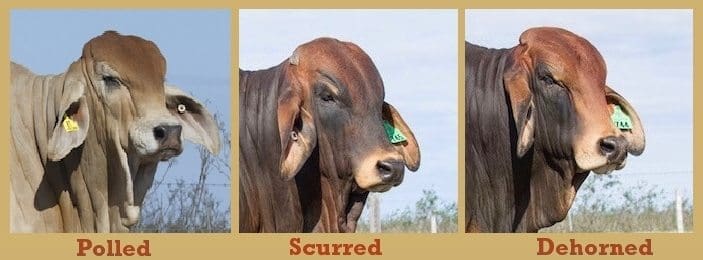This week we continue on the polledness theme started in last week’s genetics review, with a particular focus on Brahman cattle…

Images: Kent Ward
A MORE precise DNA test to identify homozygous (PP) polled cattle in Brahman and Brahman derived breeds could result from recent work by researchers at the University of Queensland.
The project also aims to develop DNA tests for scurs in Brahmans.
While the genetic variants that result in Bos taurus cattle being polled have been well identified, the genetic variant that results in polled Brahman cattle has not been identified until now, and appears to be different.
A team at the University of Queensland recently sequenced the whole genome of three homozygous polled (PP) Brahman bulls that have been widely used in the industry.
This data was used to clearly demonstrate that the genetic variant these bulls carried responsible for polledness was the “Celtic” mutation. For those with a mind for genomics, this is a duplication of a 202-base segment on Chromosome 1, and is the same genetic variant that results in polled in Angus, Limousin, Charolais, and Hereford cattle among others.
The work was presented at the recent Australasian Association for the Advancement of Animal Breeding and Genetics (AAABG) conference in Townsville Qld by Dr Ross Koufariotis, who did the work together with Professors Stephen Moore and Ben Hayes, as well as Dr Russell Lyons.
The discovery in the three homozygous polled Brahman bulls does not completely exclude the possibility of other genetic variants in Brahman cattle, and this is being followed up in a project led by Dr Lyons.
This work is from UQ’s Queensland Alliance for Agriculture & Food Innovation and is part of the Brahman Genome Sequencing Project, which involved 46 Brahmans that had their whole genome sequenced, as well as the three homozygous polls.
Zoetis test
Despite this variant, it is still widely accepted that the polled gene (P) is dominant to the horn gene (H). Most producers developing polled herds are simply selecting genetically polled bulls or semen. This will quickly lower the percentage of horned calves being born.
Commercially available tests are available including the Zoetis HornPoll test which claims to identify the following:
- Homozygous Polled (PP). This animal possesses two copies of the poll variant of the gene. This animal is highly likely to express a polled phenotype and should always pass a poll variant to its progeny.
- Heterozygous Carrier (PH). This animal carries one copy of the poll variant and one copy of the horn variant. Highly likely to express a polled or scurred phenotype and will transmit either the horn or poll variant to its progeny.
- Homozygous Horned (HH). This animal carries two copies of the horn variant of the gene. Highly likely to be horned and will always transmit the horn variant to its progeny.
The poll/horn trait is complex, and the status of an animal may differ from the expected. This could be why the discovery of a new accurate Bos indicus test to discover polled/horn status will be valuable to the northern beef industry.
- Ben Hayes and his colleagues are in the process of drafting a paper on this project, which will provide more details. Stay tuned for updates.
Belmont poll sets new record
While on the subjected of poll cattle, a new national record bull price for Belmont Reds was set recently at the Belmont Red Sale in Central Queensland, where a homozygous PP Seifert bull sold for a record price for the breed of $19,000.
Beef Central publishes an exclusive list of record prices for all significant beef breeds, both bulls and females. Click here to access.
